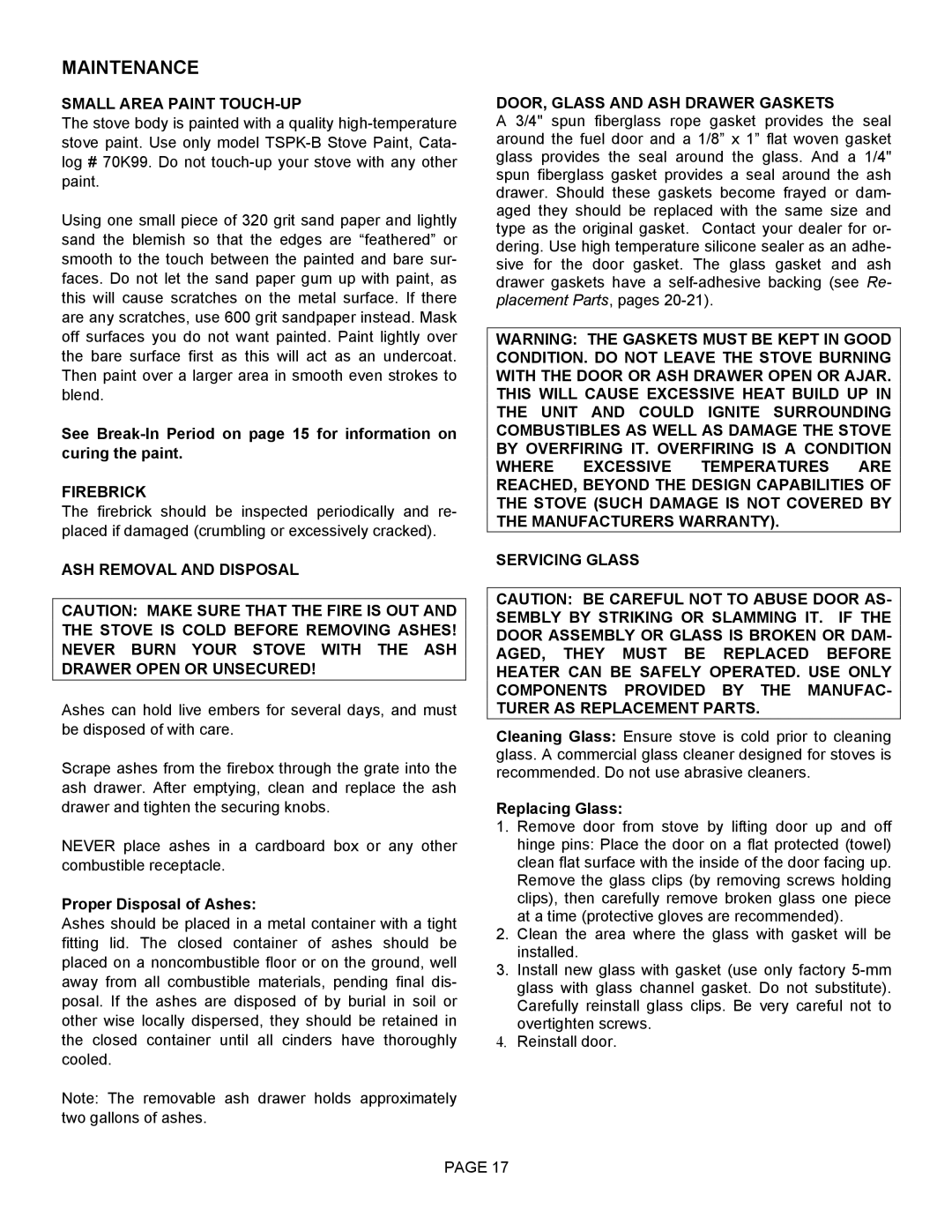
MAINTENANCE
SMALL AREA PAINT TOUCH-UP
The stove body is painted with a quality
Using one small piece of 320 grit sand paper and lightly sand the blemish so that the edges are “feathered” or smooth to the touch between the painted and bare sur- faces. Do not let the sand paper gum up with paint, as this will cause scratches on the metal surface. If there are any scratches, use 600 grit sandpaper instead. Mask off surfaces you do not want painted. Paint lightly over the bare surface first as this will act as an undercoat. Then paint over a larger area in smooth even strokes to blend.
See
FIREBRICK
The firebrick should be inspected periodically and re- placed if damaged (crumbling or excessively cracked).
ASH REMOVAL AND DISPOSAL
CAUTION: MAKE SURE THAT THE FIRE IS OUT AND THE STOVE IS COLD BEFORE REMOVING ASHES! NEVER BURN YOUR STOVE WITH THE ASH DRAWER OPEN OR UNSECURED!
Ashes can hold live embers for several days, and must be disposed of with care.
Scrape ashes from the firebox through the grate into the ash drawer. After emptying, clean and replace the ash drawer and tighten the securing knobs.
NEVER place ashes in a cardboard box or any other combustible receptacle.
Proper Disposal of Ashes:
Ashes should be placed in a metal container with a tight fitting lid. The closed container of ashes should be placed on a noncombustible floor or on the ground, well away from all combustible materials, pending final dis- posal. If the ashes are disposed of by burial in soil or other wise locally dispersed, they should be retained in the closed container until all cinders have thoroughly cooled.
Note: The removable ash drawer holds approximately two gallons of ashes.
DOOR, GLASS AND ASH DRAWER GASKETS
A 3/4" spun fiberglass rope gasket provides the seal around the fuel door and a 1/8” x 1” flat woven gasket glass provides the seal around the glass. And a 1/4" spun fiberglass gasket provides a seal around the ash drawer. Should these gaskets become frayed or dam- aged they should be replaced with the same size and type as the original gasket. Contact your dealer for or- dering. Use high temperature silicone sealer as an adhe- sive for the door gasket. The glass gasket and ash drawer gaskets have a
WARNING: THE GASKETS MUST BE KEPT IN GOOD CONDITION. DO NOT LEAVE THE STOVE BURNING WITH THE DOOR OR ASH DRAWER OPEN OR AJAR. THIS WILL CAUSE EXCESSIVE HEAT BUILD UP IN THE UNIT AND COULD IGNITE SURROUNDING COMBUSTIBLES AS WELL AS DAMAGE THE STOVE BY OVERFIRING IT. OVERFIRING IS A CONDITION WHERE EXCESSIVE TEMPERATURES ARE REACHED, BEYOND THE DESIGN CAPABILITIES OF THE STOVE (SUCH DAMAGE IS NOT COVERED BY THE MANUFACTURERS WARRANTY).
SERVICING GLASS
CAUTION: BE CAREFUL NOT TO ABUSE DOOR AS- SEMBLY BY STRIKING OR SLAMMING IT. IF THE DOOR ASSEMBLY OR GLASS IS BROKEN OR DAM- AGED, THEY MUST BE REPLACED BEFORE HEATER CAN BE SAFELY OPERATED. USE ONLY COMPONENTS PROVIDED BY THE MANUFAC- TURER AS REPLACEMENT PARTS.
Cleaning Glass: Ensure stove is cold prior to cleaning glass. A commercial glass cleaner designed for stoves is recommended. Do not use abrasive cleaners.
Replacing Glass:
1.Remove door from stove by lifting door up and off hinge pins: Place the door on a flat protected (towel) clean flat surface with the inside of the door facing up. Remove the glass clips (by removing screws holding clips), then carefully remove broken glass one piece at a time (protective gloves are recommended).
2.Clean the area where the glass with gasket will be installed.
3.Install new glass with gasket (use only factory
4.Reinstall door.
PAGE 17
